If you’ve ever opened your closet only to feel overwhelmed by the mess inside, you’re not alone. For years, my closet was a chaotic jumble of clothes, shoes, and accessories all mixed together with no real system.
I’d spend precious minutes every morning digging through piles, trying to find something to wear, and often giving up and settling for whatever was easiest to grab. Sound familiar?
After realizing how much time and energy my disorganized closet was costing me, I decided to take matters into my own hands—and dedicated an entire year to designing the perfect closet for my needs. What started as a simple clean-out turned into a complete makeover.
I learned that organizing a closet isn’t just about tidying up; it’s about creating a space that works for you, saves you time, and even sparks joy every day.
Throughout the process, I experimented with different storage solutions, layouts, and organizational tricks. Some ideas worked beautifully, while others didn’t quite fit my lifestyle. But by the end of the year, I had a closet that not only looked great but also functioned smoothly—making getting dressed easier and more enjoyable.
If you’re ready to transform your closet from a cluttered headache into a peaceful, organized space, you’re in the right place. I’m sharing my top 8 closet organizing tips that made all the difference for me.
These tips are practical, easy to follow, and don’t require expensive upgrades or fancy tools. Whether you have a walk-in closet or a small wardrobe nook, these ideas will help you create a system that fits your style and life.
So, grab a cup of coffee, get ready to clear some space, and let’s dive into the closet makeover journey. By the time you finish reading, you’ll have the know-how and motivation to finally design a closet that feels like your own personal boutique—one that makes your mornings easier and your days brighter.
Tip 1: Start With a Blank Slate
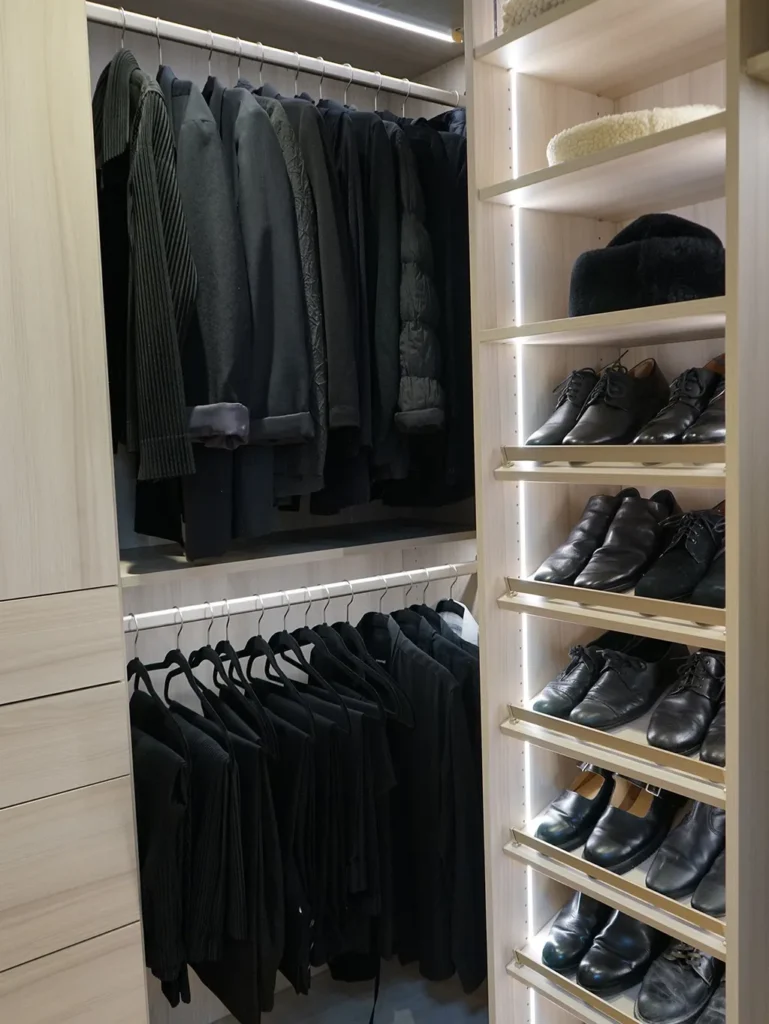
This first step might sound simple, but it’s absolutely essential—and it can be tough. To create an organized closet, you need to start by completely emptying it out. Take everything off the shelves, hangers, and floor. I know it feels overwhelming to see all your clothes and shoes in one place, but this is your chance to really get to know your wardrobe.
Why is this so important? Because it allows you to evaluate each item critically. When everything is out, you’ll notice duplicates, clothes you never wear, or pieces that no longer fit your style. It becomes easier to decide what to keep, donate, or toss.
When I did this, I made three piles: keep, donate, and repair. It helped me declutter without feeling guilty. And the best part? You get a clear vision of your space without distractions, which makes designing a layout that suits your needs so much easier.
Pro tip: Before putting anything back, clean the closet thoroughly. Dust shelves, wipe down rods, and vacuum or sweep the floor. A fresh, clean space feels inspiring and fresh.
Tip 2: Find Your Light
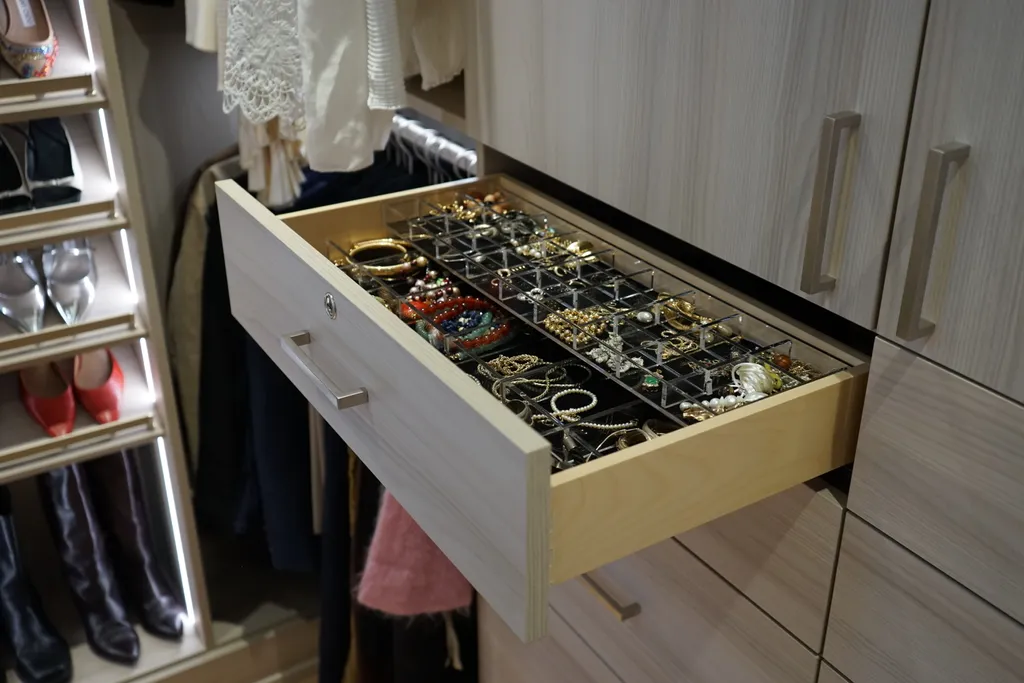
You might not think lighting is a big deal for a closet, but trust me—it is. A poorly lit closet can make even the most organized space feel cramped and cluttered. Plus, it’s tough to see your clothes clearly, which can lead to bad outfit choices or forgotten pieces.
I installed LED strip lights along the closet rods and shelves. They provide bright, even light and are energy efficient. Motion-sensor lights are another great option because they turn on automatically when you open the closet door, so you don’t have to fumble for a switch.
Natural light is rare in most closets, but if yours has a window, keep it unobstructed and clean. Light colors on walls and shelves can also help reflect light and make the space feel bigger and brighter.
Good lighting transforms your closet from a dark, stressful space into an inviting mini dressing room.
Tip 3: Great Accessorizing Starts With Good Organization
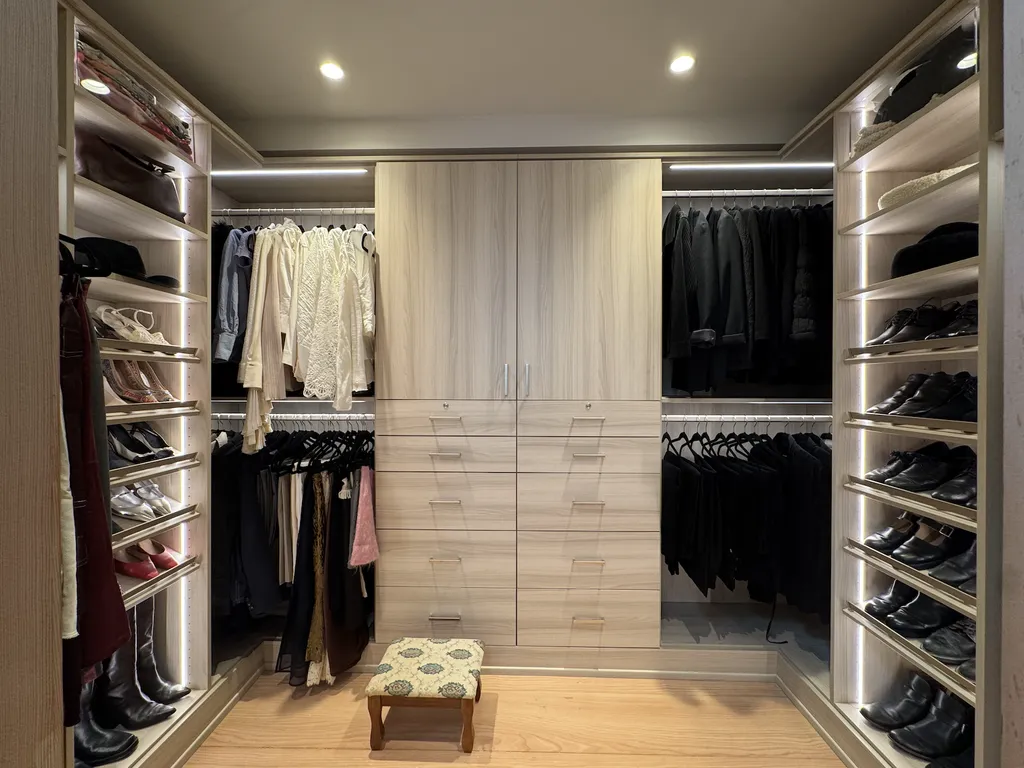
Accessories can be the hardest part of a closet to organize. Scarves, belts, jewelry, hats—they can easily become tangled, lost, or forgotten.
When I designed my closet, I dedicated specific spots for these smaller items. Drawer dividers were a game-changer. They keep jewelry separated so necklaces don’t tangle and rings don’t get lost. Small clear bins help corral scarves and belts neatly.
Hooks on the inside of closet doors or along empty wall space are perfect for hanging necklaces or bags without cluttering shelves.
I also recommend grouping accessories by type and color, so it’s easy to find the exact piece you want quickly. When everything has a place, your accessories don’t just stay organized—they become a part of your outfit decision process instead of a source of frustration.
Tip 4: Faves to the Front
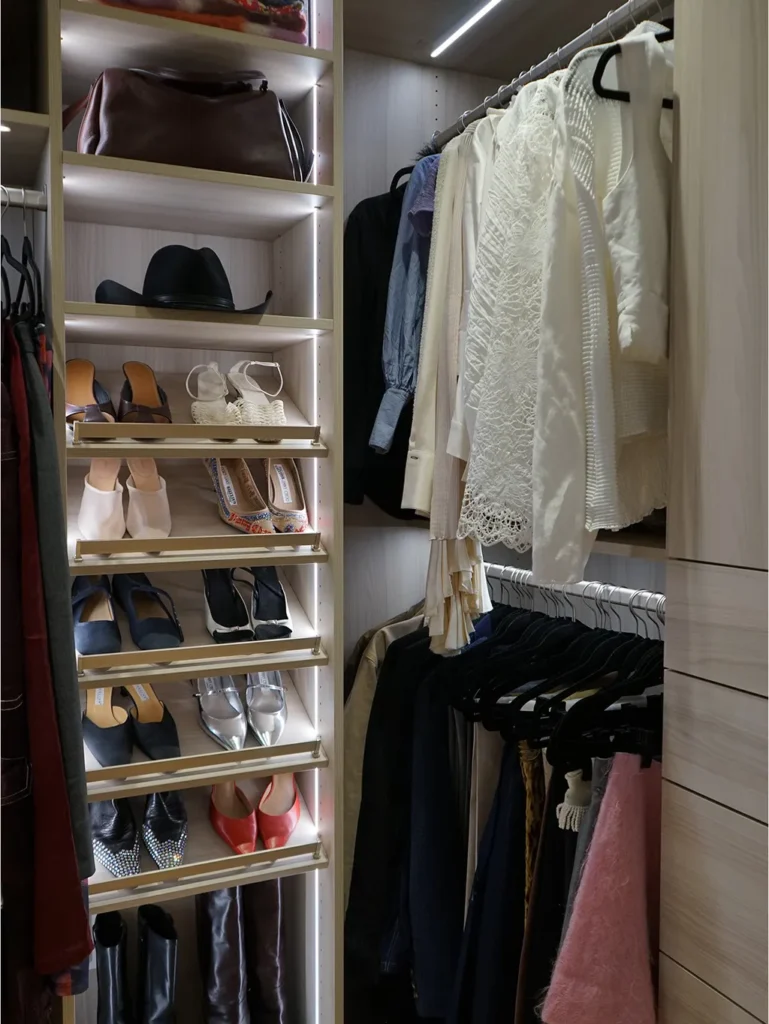
This tip is simple but makes a huge difference in daily life: keep your favorite and most-worn items in the most accessible spots.
During my closet makeover, I realized that I had to dig through piles of clothes to find the pieces I reached for every day. So, I moved those “go-to” clothes to eye level and toward the front of my closet.
This not only saves time but also helps keep the closet looking tidy because you’re less likely to throw clothes on the floor or over a chair when you can grab your favorite jacket or shirt easily.
You can apply this idea to shoes, too—keep your everyday sneakers or boots front and center and store special occasion footwear elsewhere.
This habit also gives your closet a sense of flow. When the pieces you actually wear are easy to see and grab, getting dressed becomes faster and more fun.
Tip 5: The Long and Short of It
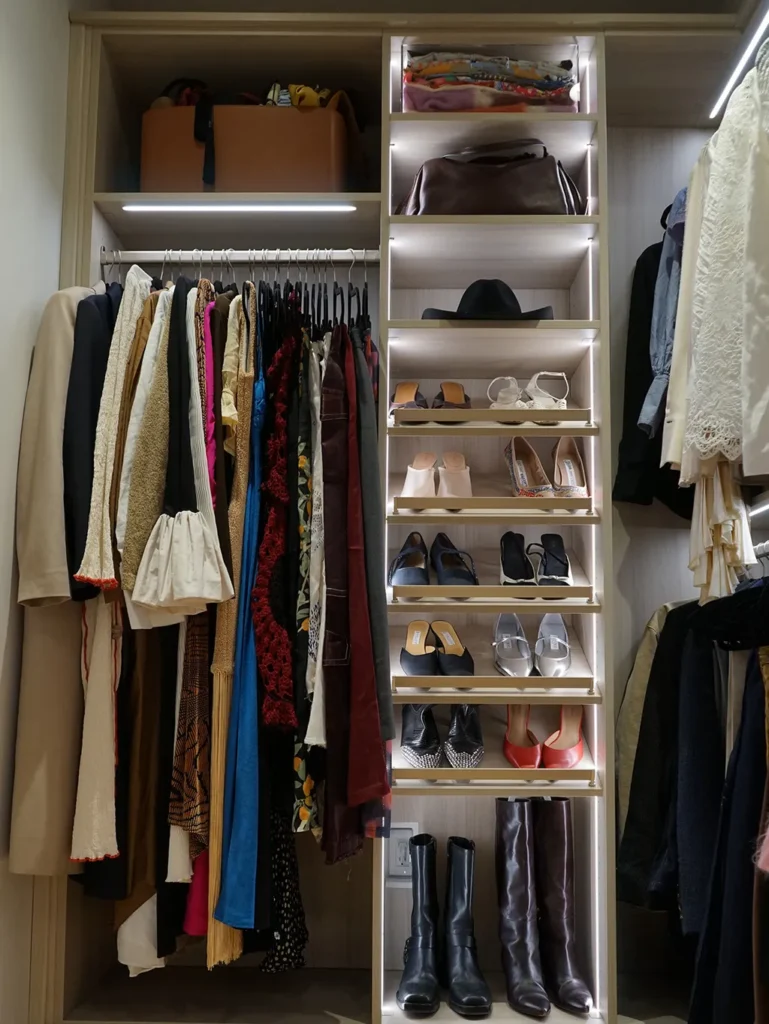
How you hang your clothes can impact how much space you have and how neat everything looks.
I organized my clothes by length and type. For example, long dresses, coats, and pants hung in one section, while shorter items like shirts, skirts, and jackets were grouped in another.
This makes it easier to find what you need because your clothes are visually grouped in a way that makes sense. It also maximizes space: by hanging short items beneath longer ones where possible, you use vertical space effectively.
If you have a double hanging rod setup, use the top rod for longer clothes and the bottom rod for shorter pieces. This helps avoid overcrowding and wrinkling.
Bonus tip: Hang items by color within these groups if you want an even more visually appealing closet.
Tip 6: Bin Wisely
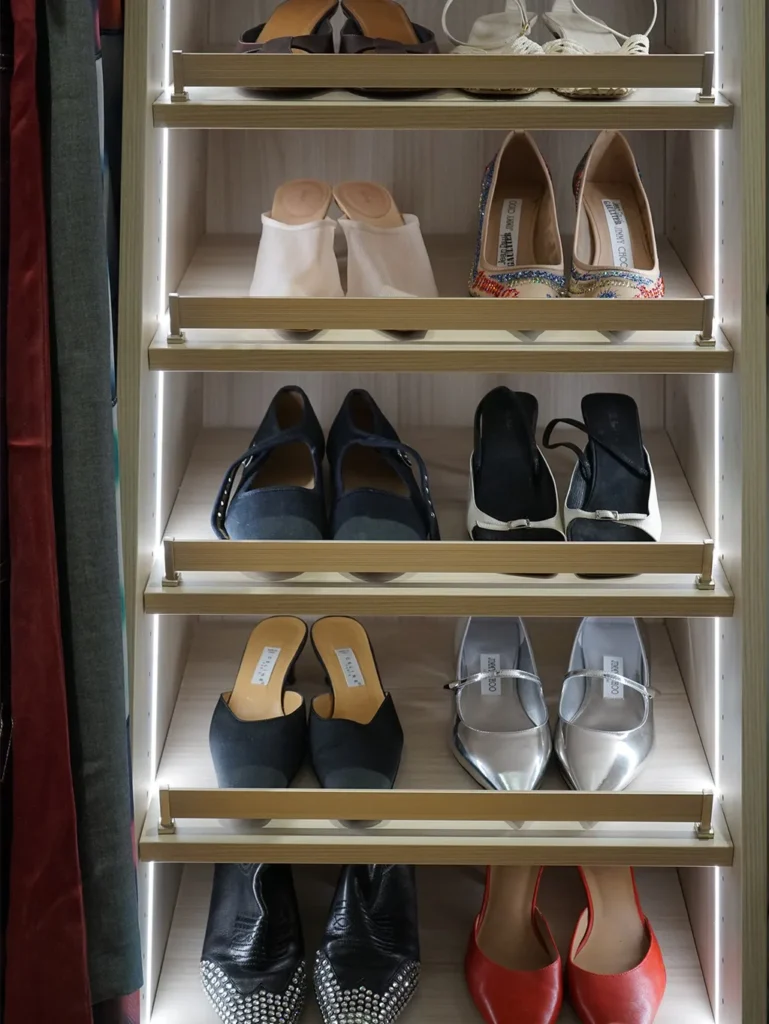
Bins and baskets are some of the most versatile organizing tools in a closet. But it’s important to choose and use them wisely.
I use bins for items that don’t need to be accessed daily, like off-season clothes, workout gear, or extra linens. Clear bins are my favorite because I can see what’s inside without digging through them.
Labeling bins is a must. I used simple, neat labels so I can quickly find what I need and avoid unnecessary rummaging.
Stackable bins save floor and shelf space. If you use fabric bins, choose sturdy ones with handles so they’re easy to pull out.
Don’t overfill your bins. Leaving a little room keeps things looking neat and prevents the bin from becoming a messy catch-all.
Tip 7: A Shoe Edit

Shoes are often the hardest part to organize because they come in so many shapes and sizes and tend to multiply over time.
I regularly edit my shoe collection. Every season, I review which shoes I actually wear and which ones I can donate or sell. This keeps my collection manageable and ensures only wearable pairs take up space.
For storage, I use clear shoe boxes stacked on shelves. This keeps shoes visible and protected from dust. For quick-access shoes, I have a shoe rack near the closet entrance.
If space is limited, consider over-the-door shoe organizers or under-bed storage bins.
Whatever system you choose, the key is to avoid piling shoes on the floor, which creates clutter and makes it hard to find pairs.
Tip 8: Maintain the System
The most beautifully designed closet will quickly become messy if you don’t maintain it. Organization is not a one-time project—it’s an ongoing habit.
Set aside 10-15 minutes each week to tidy up your closet. Return clothes to their designated spots, refold or rehang items that have slipped out of place, and reassess bins or drawers that are starting to overflow.
I find that doing this small regular upkeep prevents overwhelm and keeps my closet enjoyable to use.
Also, once or twice a year, do a mini closet audit to remove anything you no longer wear or need. This keeps your collection fresh and your space manageable.
Final Thoughts
After spending a year designing and organizing my closet, I’ve realized that a great closet is much more than just a place to store clothes. It’s a personal space that should reflect your lifestyle, make your daily routine easier, and even bring a little joy when you open the door. The truth is, an organized closet isn’t something you achieve overnight. It’s a process that takes time, patience, and a bit of trial and error. But the payoff is absolutely worth it.
One of the biggest lessons I learned is that your closet should work for you—not the other way around. What makes sense for someone else’s space might not work for yours. That’s why starting with a blank slate and taking stock of what you really own is so important. It gives you the chance to build a system that fits your unique needs. And don’t worry if it’s not perfect on the first try. Over time, you’ll find tweaks and adjustments that make it feel just right.
Lighting, organization, and accessibility all play key roles in creating a closet you’ll love. Good lighting brightens the space and makes choosing outfits easier. Smart storage solutions like bins, hooks, and dividers help keep everything in its place. And putting your favorite, most-used items front and center saves time and keeps the space feeling fresh.
Maintaining your closet is just as important as organizing it. Without regular upkeep, even the best-designed closet can quickly become messy. That’s why I recommend setting aside a few minutes each week to tidy up. It’s a small habit that makes a huge difference over time, preventing clutter from piling up and keeping your closet looking and feeling great.
Lastly, don’t forget to declutter regularly. Clothes and shoes can pile up without you realizing it, so a seasonal edit helps keep your collection manageable and ensures you’re only holding on to what you truly wear and love.
Designing my closet was a rewarding journey that taught me a lot about simplicity, efficiency, and personal style. If you’re ready to take the plunge, remember to be patient with yourself and enjoy the process. A well-organized closet isn’t just about storage—it’s about creating a space that inspires confidence and makes your everyday life a little easier.
